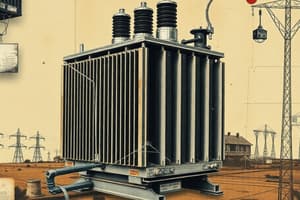Podcast
Questions and Answers
What is the primary purpose of a transformer?
What is the primary purpose of a transformer?
- To generate electrical energy
- To transfer electrical energy between circuits (correct)
- To store electrical energy
- To convert direct current to alternating current
Which component of a transformer is responsible for enhancing magnetic coupling?
Which component of a transformer is responsible for enhancing magnetic coupling?
- Coils
- Magnetic core (correct)
- Insulation
- Cooling system
What does a step-up transformer do?
What does a step-up transformer do?
- Decreases voltage and current
- Provides electrical isolation
- Maintains voltage while increasing current
- Increases voltage and decreases current (correct)
What does the turn ratio (n) in a transformer represent?
What does the turn ratio (n) in a transformer represent?
Which cooling method would be necessary for high-power transformers?
Which cooling method would be necessary for high-power transformers?
Flashcards are hidden until you start studying
Study Notes
Transformers
-
Definition: Electrical devices that transfer electrical energy between circuits through electromagnetic induction.
-
Basic Principle: Operate on the principle of Faraday's Law of electromagnetic induction, converting alternating current (AC) from one voltage level to another.
-
Construction:
- Core: Made of magnetic material to enhance magnetic coupling.
- Windings: Two sets of coils (primary and secondary) wrapped around the core.
- Primary winding: Connected to the input voltage source.
- Secondary winding: Delivers the transformed voltage to the load.
-
Types of Transformers:
- Step-up Transformer: Increases voltage, decreases current (more turns in secondary winding).
- Step-down Transformer: Decreases voltage, increases current (more turns in primary winding).
- Isolation Transformer: Provides electrical isolation without changing voltage levels.
- Auto-transformer: A single winding that acts as both primary and secondary, with a portion of it shared.
-
Key Parameters:
- Turn Ratio (n): Ratio of turns in secondary to primary winding (n = N2/N1).
- Efficiency: Ratio of output power to input power; ideally close to 100%.
- Voltage Rating: Maximum voltage the transformer can handle safely.
-
Applications:
- Power transmission and distribution.
- Voltage regulation in electrical systems.
- Used in power supplies for electronic devices.
-
Losses in Transformers:
- Copper Loss: Due to resistance in windings (I^2R losses).
- Core Loss: Hysteresis and eddy current losses in the core material.
- Stray Losses: Result from leakage flux in the transformer.
-
Cooling Methods:
- Natural Cooling: Uses air or oil and is sufficient for lower power ratings.
- Forced Cooling: Uses fans or pumps, necessary for high-power transformers.
-
Safety Considerations:
- Proper insulation and grounding to avoid electric shock.
- Maintenance checks for overheating and wear.
-
Testing Methods:
- Open Circuit Test: Determines core loss and magnetizing current.
- Short Circuit Test: Estimates copper losses and full-load current conditions.
These notes encapsulate the essential aspects of transformers within electrical machines, providing a foundational understanding of their function and importance.
Transformers
- Definition: Transformers are electrical devices used for transferring electrical energy between circuits through electromagnetic induction.
- Basic Principle: Transformers operate based on Faraday's Law of electromagnetic induction, converting AC voltage from one level to another.
- Construction:
- Core: Transformers have a core made of magnetic material to enhance magnetic coupling.
- Windings: Two sets of coils, known as the primary and secondary windings, are wrapped around the core.
- Primary Winding: The primary winding is connected to the input voltage source.
- Secondary Winding: The secondary winding delivers the transformed voltage to the load.
Types of Transformers
- Step-up Transformer: A transformer is considered a step-up transformer when it increases the voltage, resulting in a decrease in current. This is achieved by having more turns in the secondary winding compared to the primary winding.
- Step-down Transformer: A transformer is considered a step-down transformer when it decreases voltage, resulting in an increase in current. This is achieved by having more turns in the primary winding compared to the secondary winding.
- Isolation Transformer: An isolation transformer is used to provide electrical isolation between circuits without altering the voltage levels.
- Auto-transformer: An auto-transformer has one winding acting as both the primary and secondary. A portion of the winding is shared by both circuits.
Key Parameters
- Turn Ratio (n): The turn ratio (n) is calculated by dividing the number of turns in the secondary winding (N2) by the number of turns in the primary winding (N1).
- Efficiency: Efficiency is the ratio of output power to input power. Ideally, transformer efficiency is close to 100%, meaning minimal energy loss occurs during the transformation process.
- Voltage Rating: The voltage rating signifies the maximum voltage that the transformer can handle safely.
Applications of Transformers
- Power Transmission and Distribution: Transformers play a crucial role in power transmission and distribution systems, enabling the efficient transfer of electrical power over long distances.
- Voltage Regulation: Transformers are widely used for voltage regulation in various electrical systems to maintain a stable and reliable voltage supply.
- Power Supplies in Electronic Devices: Transformers serve as a vital component in power supplies for electronic devices to provide the necessary voltage levels for operation.
Losses in Transformers
- Copper Loss: Copper loss, also known as I^2R losses, result from the resistance present in the windings.
- Core Loss: Core loss encompasses hysteresis and eddy current losses within the core material.
- Stray Losses: Stray losses occur due to leakage flux in the transformer, representing the magnetic flux that does not link with both the primary and secondary windings.
Cooling Methods
- Natural Cooling: For transformers with lower power ratings, natural cooling utilizing air or oil is often sufficient.
- Forced Cooling: For high-power transformers, forced cooling methods using fans or pumps are commonly employed to dissipate heat effectively.
Safety Considerations
- Insulation: Proper insulation is essential to prevent electric shock and ensure safe operation.
- Grounding: Grounding provides a path for fault currents, mitigating the risk of electrical hazards.
- Maintenance: Regular maintenance checks are critical to detect early signs of overheating, wear, or other potential issues to prevent malfunctions. ### Testing Methods
- Open Circuit Test: An open circuit test is used to determine core loss and magnetizing current.
- Short Circuit Test: A short circuit test is conducted to estimate copper losses and full-load current conditions.
Studying That Suits You
Use AI to generate personalized quizzes and flashcards to suit your learning preferences.




